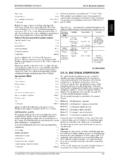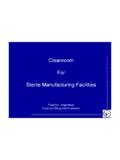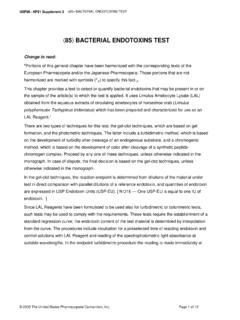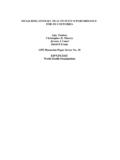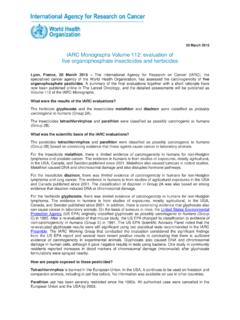Transcription of World Health Organization - gmpua.com
1 World Health Organization Supplementary Guidelines on Good Manufacturing Practices for Heating,Ventilation and Air conditioning (HVAC) Systems for Non-sterile Dosage Forms Praphon Angtrakool Working document (2004) Food and Drug Administration 1. Introduction X HVAC systems assists in ensuring the manufacture of quality products and also result in operator comfort. X HVAC systems design influences architectural layouts, with regard to items such as airlock positions, doorways and lobbies. X The prevention of the contamination and cross-contamination is an essential design consideration of the HVAC system. X The design of the HVAC system should be considered at the concept design stage. 1. 2. Glossary (1). X Cleanroom : A room or area with defined environmental control of particulate and microbial contamination, constructed and used in such a way as to reduce the introduction, generation and retention of contaminants within the area, and in which other relevant parameters ( temperature, humidity and pressure) are controlled as necessary.
2 X Containment : A process or device to contain product, dust or contamination in one zone, preventing it from escaping to another zone. 2. 2. Glossary (2). X Contamination : The undesired introduction of impurities of a chemical or microbial nature, or of foreign matter, into or on to a starting material or intermediated, during processing, sampling, packaging or repackaging, storage or transport. X Cross-contamination : Contamination of starting material, intermediated product or finished product with another starting material or material during production. 3. 3. Scope X HVAC systems for oral solid dosage facilities X The three primary aspects addressed in this manual are the role that the HVAC system play in Y product protection Y personnel protection Y enviromental protection 4. Protection Aspects GMP Manufacturing Environment Product Protection Personnel Protection Environment Protection Contamination Prevent contact with dust Avoid duct discharge (Product & Staff).
3 Protect from Product Prevent contact with fumes Avoid fume discharge (cross-contamination). Correct temperature & humidity Acceptable comfort conditions Avoid effluent discharge SYSTEM. SYSTEM VALIDATION. 5. 4. Product Protection (1). Contamination control Cleanroom concept Level of protection Air filtration to control contamination Contamination by HVAC plant Contamination by staff Airflow patterns Uni-directional flow protection Infiltration 6. 4. Product Protection (2). Cross-contamination protection Directional air movement - Displacement concept - Pressure differential concept - Physical barrier concept - Selecting the segregation concept Uni-directional flow protection Cross-contamination via HVAC supply air Cross-contamination due to fan failure 7. 4. Product Protection (3). Temperature and Humidity General requirements Product temperature requirements Product humidity requirements Microbial growth 8. 5. Personnel Protection Protection from dust Dust classification Uni-directional flow protection Point extraction Directional airflow Air shower Protection enclosures Operator comfort 9.
4 6. Protection of the Environment Extraction air dust Fume removal Effluent discharge 10. 7. System and components Air distribution Air handling unit configurations Re-circulation system Full fresh air systems Additional system components 11. 4. Product Protection (1). Contamination control X Through all stages of processing, product should be protected from contamination and cross-contamination. X These include contamination resulting from Y inappropriate building finishes Y plant layout Y poor cleaning procedures Y lack of staff discipline Y poor HVAC system 12. Cleanroom concept X Pharmaceutical manufacturing facilities where pharmaceutical products, utensils and manufacturing equipment are exposed to the environment, should be classified as cleanrooms . X The shell-like containment control concept : The process core is regarded as the most stringently controlled clean zone which is protected by being surrounded by cleanrooms of a lower classification. X Internal contaminants should be removed by dilution and flushing of contaminants in the room, or by displacement airflow.
5 13. Shell-like containment control concept OUTDOOR ENVIRONMENT. PERSONNEL MOVEMENT. PERSONNEL MOVEMENT. ANCILLARY AREAS. CLEANROOMS. MATERIAL TRANSPORT PROCESS CORE FINAL PRODUCT TRANSPORT. CLEAN ZONES. WASTE. 14. Cleanroom condition X as built : condition where the installation is complete with all services connected and functioning but with no production equipment, materials, or personnel present X at rest : condition where the installation is complete with equipment installed and operation in a manner agree upon by the customer and supplier, but with no personnel present X operational : condition where the installation is functioning in the specified manner, with the specified number of personnel and working in the manner agreed upon 915. Cleanroom condition as built at rest in operation air air air 16. Cleanroom concept (cont.). Many multinational pharmaceutical manufacturers have their own minimum air change rate standards for oral dosage facilities, and these typically vary between 6 and 20 air changes per hour.
6 Generally a room that is tested for an operational condition, should be able to clean up to a higher at rest cleanroom classification, after a short clean-up condition. The clean-up time should normally be in the order of 20 minutes. 17. Level of Protection (1). X Level 1 (General) : An area with normal housekeeping and maintenance. ( Warehousing, Secondary Packing). X Level 2 (Protected) : An area in which steps are taken to protect the exposed drug substance from contamination or degradation. ( Manufacturing, Primary Packing, Dispensing, etc.). X Level 3 (Controlled) : An area in which specific environmental conditions are defined, controlled and monitored to prevent contamination or degradation of the drug substance. 18. Level of Protection Typical Zone Typical Dress Code GMP Guides ISO Class Equivalent Street, canteen External External Outdoor clothes Receipt & dispatch Level 1 or Unclassified ISO Class 9 Appropriate to area Warehousing, offices Level 1 or Unclassified ISO Class 9 Appropriate to area Weighing & dispensing Level 2 background ISO Class 8 background Clean garments Level 3 open product ISO 6 or 7 open product Blending Level 2 or 3 ISO Class 8 or 7 Clean garments Granulation Level 2 or 3 ISO Class 8 or 7 Clean garments Milling Level 3 ISO Class 8 or 7 Clean garments Encapsulation & Level 2 ISO Class 8 Clean garments compression Coating Level 2 ISO Class 8 Clean garments Primary packing Level 2 or 3 ISO Class 8 or 7 Clean garments Secondary packing Level 1 or Pharmaceutical ISO Class 9 Captive coat, hat and overshoes Non-sterile processing Controlled or Class 100000 ISO Class 8 Clean garments (in operation).
7 Rooms where filling takes Clean or Class 10000 ISO Class 6 or 7 Sterile garments place (in operation). Point of fill or other aseptic Critical or Class 100 ISO Class 5 Sterile garments operations (in operation). Change rooms & airlocks The same classification as the The same classification as the Change to garments for the area they serve area they serve higher classification 19. Level of Protection (3). X Level 1 protection and Pharmaceutical conditions can be equated with and ISO Class 9 condition. X The most common applied classification for open product zones in a solid dosage plant is a grade D. classification. X Grade D equates to particulate level classification of ISO 14644-1 Class 8, at rest , measured against particles size of m and 5 m 20. Air filtration to control contamination X Referring to actual filter efficiencies can be very misleading as there are currently many different test methods, and each results in a different value for the same filter. X Efficiencies of Air Filter Y Pre-filter (25 - 30 % ARRESTANCE).
8 Y Medium Filter (90 - 95 % ASHARE 52-76). Y HEPA Filter ( > % DOP). X Back-up HEPA filter X Good pre-filter extents the life of filters downsteam. 21. Filter classes Dust filters Standard Aerosol Coarse Fine HEPA ULPA. Dp > 10 m 10 m > Dp > 1 m Dp < 1 m G1 - G4 F5 - F9 H 11 - 13 U 14- 17. EN 779 Standard EN 1822 Standard 22. Classification of filters Classification of filters according to their efficiency Average Efficiency Peak Arrestance Integral Value Local Value Retention in % Penetration Efficiency Penetration F9 85 H11 95 H12 5x10-3 25x10-3. H13 5x10-4 25x10-4. U14 5x10-5 25x10-5. 23. Filter HEPA or tertiary filter Primary panel filter Secondary filter 24. Contamination by HVAC plant X Materials for components of an HVAC system should be selected with care X Contamination into the air steam should be located upsteam of the final filters X Services are accessible from outside the processing area 25. Contamination by staff X Airflows should be planned in conjunction with operator locations, so as to minimize operator contamination of the product and also to protect the operator from dust inhalation.
9 X Where the product could be harmful to the operator, an alternative arrangement should be made. X Cosmetics such as facial make-up are a major source of contamination 26. Air flow patterns X Supply air diffusers of the high induction type should not be used in a cleanroom X Air should be exhausted from rooms at a low level. X Recommended supply air diffuser Y Perforated plate diffuser Y Swirl diffuser 27. Induction diffuser (not recommended). Induced room air High induction office type diffuser mixing with supply air (avoid). Return Air Return Air 28. Perforated plate diffuser (recommended). Perforated Plate diffuser Reduced Induction of air Return Air Return Air 29. Swirl diffuser (recommended). Swirl diffuser Reduced Induction of air Low induction swirl diffuser (preferred). Return Air Return Air 30. Swirl Type air diffusers with terminal filters 1. 2. 3. 4. 1 Filter 3 Register outlet 2 Tightening frame 4 Screw fixation for register 31. Uni-directional airflow protection X Sampling should be carried out in the same environmental class that is required for the further processing of the product.
10 X Sampling should normally be carried out under a uni-directional airflow sceen. Uni-directional flow can be Y Vertical flow ( m/s + 20 %). Y Horizontal flow ( m/s + 20 %). 32. Infiltration X Manufacturing facilities should be maintained at a positive pressure relative to the outside, to limit the ingress of contaminants. X Where facilities are to be maintained at negative pressures relative to ambient, in order to prevent the escape of harmful products to the outside (such as penicillin and hormones), then special precaution should be taken. X Negative pressure zone should, as far as possible, be encapsulated by surrounding area with clean air supplies, so that only clean air can filtrate into the controlled zone. 33. Cross-contamination protection X Through all stages of processing, products should be protect from cross-contamination X This can achieved with the aid of the following methods. Directional air movement X The pressure cascade should be such that air flow from the corridor into cubicles, resulting in dust containment 34.




